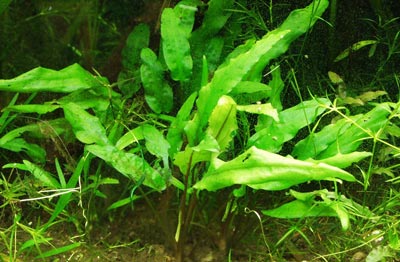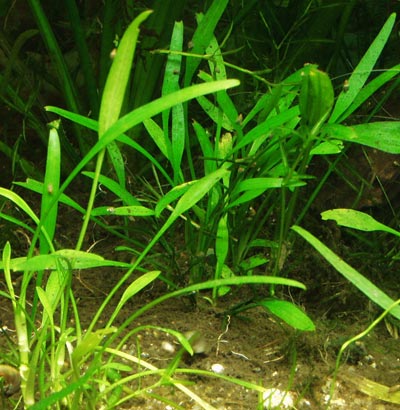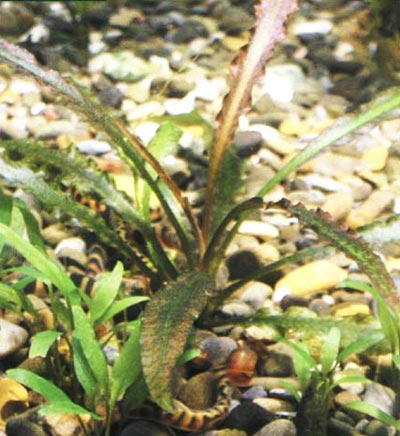

Another common plant found in many aquariums and paludariums, and one that will thrive fully submerged, partially submerged, or fully emersed are plants in the genus Cryptocoryne - though typically referred to as just Crypts. Due to their ability to withstand varying water levels, they make excellent subjects for paludaria. They occur in the wild in slow moving rivers, streams and even temporary bodies of water; naturally surviving as water levels raise and lower again during different seasons. There are dozens of different species, typically hailing from South East Asia - India, Thailand, Indonesia, the Philippines, Sri Lanka etc. There are many different sized crypts, suitable for different roles in the paludarium, with different leaf shapes, textures and colours. There are also numerous cultivars, some of which are very attractive indeed.



Plants of this genus will typically do equally well when fully submerged or growing emersed in the paludarium. Coming from hot humid countries, they do require a level of continual moisture to thrive, so planting semi-submerged at the waterline is an excellent way to give them the moisture they need, and to break up the artificial border between land and water in the typical paludarium. Although there are many different species, the most widely available are typically the most hardy. These are incredibly easy to grow plants, and they will do well under most conditions, however, there is quite some variation within the genus, and it is worth examining a few of the different species to see which are most appropriate for your particular paludarium set-up.
Though easy to care for, crypts may take time to adapt to a new environment, and may lose leaves under certain conditions - this may include plants grown emersed and then re-planted underwater. Although somewhat alarming, this is not too much of a problem, as the roots survive, and plant will recover. Most species will reproduce readily under water, typically sending out runners to produce new plants. When grown emerged, however, they may also flower and drop seeds. They tolerate most water conditions and lower light levels, so can be grown in the shade of other plants. In general, aquarium grown specimens rarely reach the sizes of those in the wild.
Cryptocoryne parva a wonderful small crypt that only grows a few centimetres tall. This can create a superb living carpet in the foreground of an aquarium, however only in good light conditions. The addition of some CO2 can improve growth rates. It is valued as the smallest available crypt, but is slow growing, and forming dense growth can take considerable time. Certainly worth the wait though. In the paludarium, this species is perhaps best for shallow regions (with good light penetration) and not under the shade of larger plants. buy
Cryptocoryne willisii another species common in the aquarium trade, C. willisii is a small-medium plant - larger than C. parva above, that does well both submerged and emersed. Somewhat quicker growing than C. parva, and an excellent species for the shallows of a typical paludarium or riparium. buy
Cryptocoryne wendtii a medium-sized species that is very widely available in aquatic stores, and one that is regularly hybridized with other crypt species. It is quick growing and very easily propagated. Numerous colour forms are available, with all manner of red, green and brown foliage. Excellent for creating some interest in an otherwise largely green paludarium. Again, thrives both in and out of water, so great for the water's edge in paludaria. buy
Cryptocoryne becketii this Sri Lankan species is a widely available in the aquarium trade. A medium-sized species, with nice dark leaves; slow growing but hardy. Another easy species buy
Cryptocoryne balansae This is an interesting crypt, tall, with very long crimp textured leaves. It is widely distributed in rivers in South East Asia. In the aquarium, leaves reach up to and across the water's surface. In a shallow paludarium, they will grow emerged. Certainly one of the most attractive species. buy
This wonderful 3 foot wide tank has a waterproof glass bottom, and adequate front window ventilation to keep the front glass clear. Although marketed as a Terrarium, it works as the perfect Paludarium. Front-opening doors, and removeable top for easy access and effective maintenance. Available in a wide range of sizes: with a larger surface area for ground/water dwelling species, or taller for leaf dwellers. Suitable for just about any paludarium inhabitant.
The top is equipped with closable inlets on both sides - this allows access for wires and tubing without offering an escape route for paludarium animals or the tiny invertebrates with which they are being fed. Suitable for powering Heat Wave rocks, waterfalls, filters and sensors, or injecting water through misting systems, external canister filters, etc.
All in all a great enclosure, providing a perfect environment for plants and animals, yet easy maintenance for the paludarium keeper. Available from Amazon and other good pet stores.